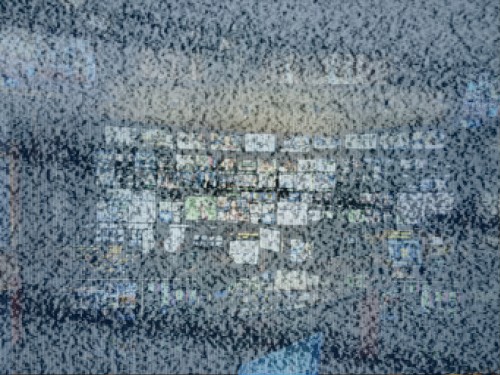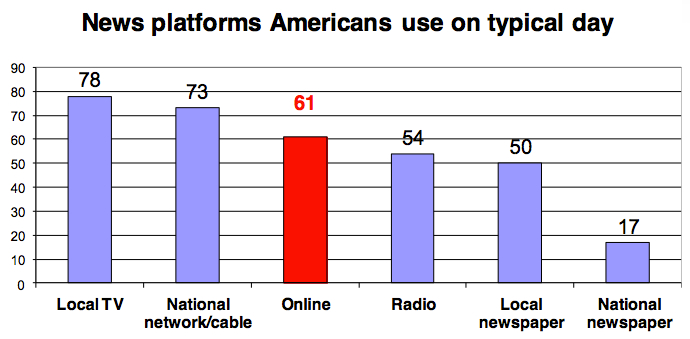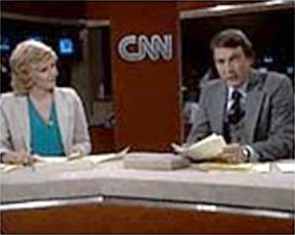
The very fact that your eyes rolled (just a little bit) at the title tells you that it is absolutely true. So true its obnoxious to proclaim it. Perhaps cable news died when CNN made a hologram of Jessica Yeller and beamed her into the “Situation Room” just to talk horse race bullshit during the 2008 election. Or maybe it was as far back as 2004 when Jon Stewart went on Crossfire and shattered the fourth wall by excoriating the dual hosts for destroying public discourse. The beginning of the end might be hard to pinpoint, but the end is certainly coming. Fox News had its lowest ratings since 2001 this year, but still has more viewers than CNN & MSNBCNEWSWHATEVERITSCALLEDNOW combined. Even if ratings weren’t a problem, credibility certainly is. Imagine if CNN stopped calling themselves the “Most Trusted Name In News” and used the more accurate, “A Little Over Half of Our Viewers Think We’re Believable.” By now it is clear that the zombified talking heads of cable news are either bought and sold, or just irrelevant. Cable news channels’ hulking, telepresent bodies have been run through and left to rot on the cynical barbs of political bloggers and just about anyone at a comedy shop’s open-mic night. This last series of screw-ups in Boston (here, here, here and unless it was avant-garde electronic literature, here) begs the question if cable news channels can even tell us what’s going on anymore. Cable news is dead, but something keeps animating the corpse.
Perhaps its more accurate to say that cable news has a terminal illness. The state of cable news is still pretty good, but there are few signs of stability or long-term health. Below are a few pertinent figures presented by Lee Rainie (@Lrainie), the Director of Pew Research Center’s Internet & American Life Project, at the International Journalism Festival last year:
- The percentage of people reporting that they get their news from television has decreased from 68% in 1991 to 58% in 2010.
- Since 1998, the percentage of people that say they don’t follow the news at all went up from 14% to 17%.
- Over the last decade, more people say they check the news “from time to time” rather than at regular times.
- 63% of Americans think the news is politically biased, up from 45% in 1985. Republicans and independents largely drive this figure.

CNN might not be shuttering its touchscreens anytime soon but the trend is clear: television news is still dominant but not for long. The demand for cable news (or any news for that matter) is shrinking, and yet the supply seems to grow. Al-Jazeera is coming to the United States, and there are dozens of online news outfits that offer hours of original reporting distributed as audio and video content. Some are great; others make you question the wisdom of the first amendment. All are looking to specialize, carve out niche viewer markets, and remain solvent in an industry that is constantly being disrupted by new technologies and socio-political trends. One could argue, like Globalvision Inc’s Rory O’Conner does, that new players signal a lack of quality product, not a lack of demand:
…this is an excellent time for any entity interested in making an impact in the increasingly dismal US cable news environment. Fox News, which has long been the industry leader in ratings, has lost huge audience share since the re-election of its bete noir Barack Obama. Fox stars like Sean Hannity are reportedly “haemorrhaging viewers” – Hannity has lost nearly half of his audience since the election, with the biggest drop in ratings coming in the coveted 24 to 54-year-old demographic, which had been one of his strongest groups of viewers.
We won’t know until Al-Jazeera America is up and running, if O’Conner is right and declining viewership has more to do with terrible reporting and producing, than an overall declining interest in this thing invented in the 80s called cable news. This seems unlikely, given Rainie’s presentation data that suggests the changing technology has changed how we consume and think about news. News isn’t something we passively receive; it is part of a conversation. Even if I see a story on television I might want to express my feelings about it on Facebook. I might also want to sign a petition, change my profile picture in solidarity, and engage in vigilante justice. The news segments and interviews are cannon fodder for political arguments with my cousin and talking points for when I’m feeling preachy. The digital artifacts that contain Breaking News™ are rallying points for debate and action.
https://twitter.com/irevolt/status/325936703950974977
Spivak once observed that theory is like the currency of ideas. Just as Dollars and Yen make goods easily comparable and exchangeable, theory makes it easier to circulate ideas. News stories work in a very similar way. Monologues and dialogues are edited down to provide a single, highly refined narrative. It does not matter whether that narrative strives to invoke partisanship, entertain, distract, or appear as objective fact, they are all compressed into the two socio-technical codes that permit the widest consumption: General American English and H.264. News propagates faster and wider if it is easily compatible with the places we meet and talk with one-another. TVs are still in family homes, bars, and offices, but they’re competing with the smartphone in your pocket and the computer that you’re supposed to be working on. That news segment will only go so far on television. But dice up that Maddow interview into 8-minute segments; slap a share this plugin on it and it’ll be the new reason why I won’t speak to my friends from high school.

These are very dangerous waters. Spivak’s currency metaphor lets us commit an egregious amount of moral relativism. Agnostic to content, we can treat all stories told in the news genre as the same kind of artifact. Glenn Beck and Democracy Now! are about as different as Fruit Loops and Kashi cereal. There might be some nutritional differences, but they’re both highly processed, pre-packaged goods meant for mass consumption. If news is only as good as its ability to traverse our augmented society, then a story about a water-skiing squirrel bests an exposé on Chinese factories so long as the former is on Youtube and the latter remains on paper. This doesn’t seem totally right. The death of newspapers and the terminal illness contracted by cable news is not a case of technological disruption: it’s a crisis of legitimacy.
Remember, we’re not talking about news here. Not journalism. The news contains journalism but it also has corporate press releases, weather forecasts, recipes from Emeril Lagasse, and Amanda Bynes’ latest tweets. Journalism is a profession. News is a sociotechnical phenomenon. There is some excellent journalism being done around the world, but very little of it has anything to do with cable news. O’Conner might be right, and Al Jazeera can succeed based on quality content, but I remain unconvinced that critical thought can be conveyed through the current sociotechnical apparatus.
Last week, Whitney wrote about the documentation of tragedy using Vine. She noted that the technological affordances of the service, “reduces the tragedy of a violent act down to a bright orange flash.” The widespread use of vine as a documentary device occludes complexity and nuance. Cable news does something similar. It tells one kind of story, and it’s the kind of story that fewer people are willing to listen to. Cable news stories are positively hackneyed compared to our fictional ones: The news still has obvious protagonists and predictable villains. (Of course the same people play opposite roles depending on the channel.) The characters are woefully stereotypical and the production value just isn’t there. How can this be the case? How can these global news organizations that have amassed so much capital do so poorly?
Despite (or because of) all the fancy-looking sets and far-flung bureaus, even national news organizations run on a shoestring budget. Networks will gladly run a story about your new drug breakthrough if you already wrote the copy and provide high-quality video of interviews with the scientist. Pharmaceutical companies do just that, as do governments, universities, and NGOs. The Yes Men, a group of activists that expose corruption through manipulating this corporation-to-corporation communication scheme. They film and produce their own actions. You’re more likely to get airtime if you hand them a finished product. (Note in the CNN segment below, the black boxes that in the top right that show the various sources that provided the content.)

This past week of horrendous events drove a massive boost in ratings for all three cable news outlets, but all they could deliver were confused accounts and vacuous speculation. At the moment when everyone was watching, all they could muster were wild accusations about Saudi Nationals and bloviating uncritical praise for police authority. Watching the news, something that should be as serious and utilitarian as it gets, is now a guilty pleasure. Meet the Press is just like Storage Wars: “I know it’s all staged but its fun to watch.”

The thoughtless confession that news is sensationalized and uncritical will beget more sensationalism and uncritical analysis. There will always be a wide selection of talking heads ready to offer speculation, fear, and misinformation. The good news in all of this, is that smart people are excited and increasingly more desperate to share their ideas too.
Ana Marie Cox (@anamariecox) gives an interesting insider’s perspective on the economy of talking heads [PDF]:
Going on TV makes my print employers happy. It makes me happy, too: it’s a relatively cost-free way of saying to a larger public what I write for my readers. To be completely honest, it’s fun. And the vast majority of the talking heads you see on cable news are doing it for the same reasons I am: it makes their employers happy, and it’s mildly exhilarating, like the rollercoasters you don’t have to be tall to ride. They are not doing it for the money, believe it or not. Only a fraction of the pundits appearing on any given show are paid “analysts.” Most of them are remunerated in more existential terms.
I am pegging my hopes on those existential remunerations. I know that there are lots of people, with a lot of smart and interesting things to say who want to get them out to a general public. Some might be practiced in the Art of the Talking Head like Cox, but others want a different medium. That is why, according to media scholar Robert McChesney, “journalists rank among the leading proponents of media reform. They know firsthand how the media system is overwhelming their best intentions and their professional autonomy, and unless the system changes there is little hope for viable journalism.” The econometric language I have (intentionally) used throughout this essay will have to be abandoned if decent journalism is to prevail and critical thought brought to the issues of the day. Ted Turner’s 1980s behemoth has to go, and in its place should stand something leaner and smarter.
McChesney says the solution is more autonomy for individual journalists. But he falls prey to naïve objectivity:
The solution to this problem—then as now—was professional autonomy for journalists. Trained, professional reporters and editors who were politically neutral would cover the news in an objective manner. The political views of the owners and advertisers would be irrelevant except on the editorial page. This was the revolutionary idea of separating editorial from business, like the separation of church and state.
Laurie Penny (@pennyred) confronts this myth head-on in Jacobin Magazine:
The idea of the standoffish white Western bloke in a tie as the universal journalistic eyepiece was able to develop because we have spent centuries seeing the world purely through the eyes of white men. Right now, that’s changing. Journalism is changing, and the internet is driving an explosion of media production from people all over the world who understand that subjectivity doesn’t have to mean innacuracy, especially when you’re telling stories.
If we could bridge McChesney and Penny at all, it would look something like strong objectivity. Developed by Sandra Harding, the theory of strong objectivity states that detailing the same events from multiple subjective points of view creates a stronger form of objectivity. Multiple subject positions are much more useful than a single person feigning value neutrality. Imagine, instead of a single Associated Press and its various cable flavors, there was a federated network of independent journalists that exchanged and contributed to covering individual events. Stories would cluster around events and those events are regularly summarized and distilled in multipartisan meta-reports that are updated as events unfold. Why do stories need to be “anchored” by a person behind a desk anymore? Instead of meaningless banter, spend the time drilling down into specific angles that might be too specific for a general audience but very valuable to a sizable plurality. Cable news was a fad that started in the 80s and like Members Only jackets, enjoyed a quiet acceptance in the 90s and resurgence in the early 2000s. Today, the audience for cable news is literally dying and with them goes this particularly strange technologically mediated relationship with current events. There might always be a channel or two that calls itself news, but that will be (again, like Members Only jackets) a consciously and obviously guilty pleasure.

Comments 5
BBC Facebook? | Digital America - The Journal — April 24, 2013
[...] A take-no-prisoners critique of cable news from Cyborgology. [...]
In Their Words » Cyborgology — April 28, 2013
[...] “Cable news is dead, but something keeps animating the corpse” [...]
Can We Make an Anti-Racist Reddit? » Cyborgology — May 9, 2013
[...] starts talking about the poor and lack of services in his neighborhood, but perhaps this is a different problem entirely. One certainly does get the sense however, that Redditors aren’t the only ones focusing on the [...]
On Facebook, Hating CNN » Cyborgology — July 5, 2013
[...] different demographics. It is constantly being called out for doing all of the things we know are wrong with American cable news. There are dozens, in some cases even hundreds, of comments about calling a revolution a coup, [...]
You Won’t Believe What This Web Site Does to The Liberal Left! » Cyborgology — October 11, 2013
[...] Daily Show has its own set of problems, as do the other corporate media outlets that provide grist for Upworthy’s soundbite mill, but the fact that Upworthy serves up content [...]